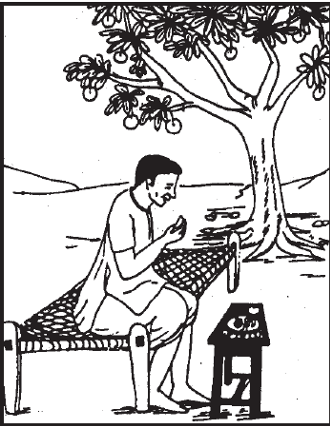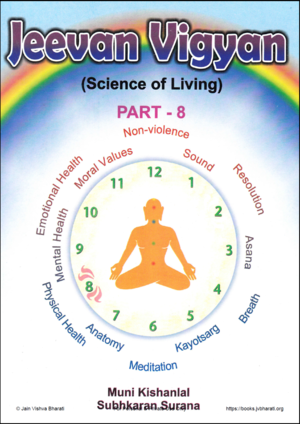Once a lady approached a sage. She wanted to find a solution to her problem. She bowed before the sage respectfully and said, "Gurudev! I have a weakness. Please be kind enough to advise me how to correct it." The sage asked her to describe the problem which was causing so much distress to her.
She said, " my problem is that I am unable to perform pooja". The sage asked her, "Don't you have faith and devotion required for pooja?" The lady replied, "Gurudev! I do have faith and devotion but I do not get enough time for it. Ours is a large family. Cooking for all family members, looking after the needs of children and attending to multitude of other domestic chores takes up most of my time. However, I lead a pious life. I do not quarrel. I do not tell a lie. I do not beat up children. I behave cordially with others. I always cooperate with others and help people according to my capacity. But all this is of no use when I cannot perform pooja. I do not have time for pooja. This is the cause of my distress. Please help me."
The sage smiled and said, "Not to quarrel and serve others are also religious deeds. To speak the truth, to be cordial to others, to live peacefully with others and to help them, are these also not rituals of pooja? To transform religious beliefs into one's thought, behaviour and character is the greatest and the holiest form of performing pooja."
These days, the practical aspect of religion has become feeble. Merely carrying out rituals and ensuring correctness of procedure have assumed greater importance. The common man, therefore, thinks that carrying out the rituals of worship is the only way of worship. It is incorrect to say that by not performing rituals, a person is not following the religious beliefs and practices.
India is a very big country. People here follow various religions—Hinduism, Sikhism, Buddhism, Jainism, Christianity, Islam etc. It is a cause of anguish that because of minor differences in opinions, rituals and beliefs these religions have been sub-divided into numerous creeds, sects and cults.
Basically, a religion is like a tree. Its subordinate creeds, sects and cults are like its branches. Together, all big and small branches form the tree. Branches, when separated from the tree cannot survive. Similarly, without branches a tree cannot be called a tree.
Creeds, sects and cults are within the main body of any religion.

Let us consider another example. Religion and sect bear same relationship to each other as the peel and pulp of a fruit. The peel and pulp are complementary for they make a complete fruit. Similarly, religion and sect are inseparable.
The outer peel and pulp are of course integral parts of a fruit. But the usefulness of the outer peel ends as soon as the pulp is eaten. At this stage the outer peel is discarded or thrown away. Exactly in the same way when we cross the limit of a sect and enter the realm of main religion, we are coming to a higher level of thought than that of a cult or sect. Our country is a land of diversity. There are so many languages, castes and creeds here. Whatever may be the religion that we believe in, we are all Indians. We are one Nation. This is SECULARISM.
We may believe in any religion or we may belong to any community, but we must respect and have goodwill for all other religions and communities. We should not highlight differences among other communities and religions. Then only our secular outlook will strengthen. We would be able to call ourselves Indians with a true sense of pride.
Men are not born enemies. We are the branches of a same tree. Then, how can two branches be in opposition to each other? If we are born in a particular community that believes in particular religion, we do not become enemies of people who have different faith. This distinction has been created by those who stand to gain by generating ill will amongst others. Religions and sects should spread amity and goodwill among all people.
In the past some communities did come forward to remove all artificial differences between man and man. But after sometime, such movements became weaker. In some cases, reformers joined the group of exploiters and selfish ones. As a result of this, differences between man and man grew, leading to many other problems. The only reason for this sorry state of affairs is the egoist attitude of religious fanatics and of those elements whose selfish interests are protected by keeping a man apart from other man on flimsy grounds.
If communal harmony or SECULARISM is to flourish, such egoist and self-interested elements must be weeded out. Only then the country will become a truly secular state. No particular community should be treated partially or accorded a more prominent status than others. All communities must be treated on the same level of equality. Every person should be allowed to worship the way he wants. Nobody should criticize the beliefs and rituals of others. Only in this way we can bring all communities and religions at one platform and communal harmony will flourish.
ANUPREKSHA OF COMMUNAL HARMONY—SECULARISM
- Mahaprana dhvani: 2 minutes.
- Kayotsarg: 5 minutes.
- Visualize and experience that we are inhaling pink coloured rays, with every inhalation, pink-coloured rays are entering into our body—3 minutes.
- Concentrate on the anand kendra (in exact center of the chest, near the heart) with pink colour.
- Concentrate on the anand kendra and carry out the anupreksha:
"I will keep myself away from religious fundamentalism. I will develop goodwill towards all other communities and creeds". Repeat these words 9 times. Carry out mananas japan with these words 9 times.
Contemplate:
"I must preserve goodwill for all people belonging to different religions and communities. I must shun false notion of high consideration for myself and will not treat others as inferior. By doing so, I would be able to take my country forward towards communal harmony and secularism"—5 minutes.
- Complete the dhyan with Mahaprana dhvani—2 minutes.
EXERCISE
- What is the difference between a religion and a community? Explain with examples.
- Describe all stages of anupreksha of secularism—the anupreksha which implements the life-values of secularism in day to day life of an individual.
